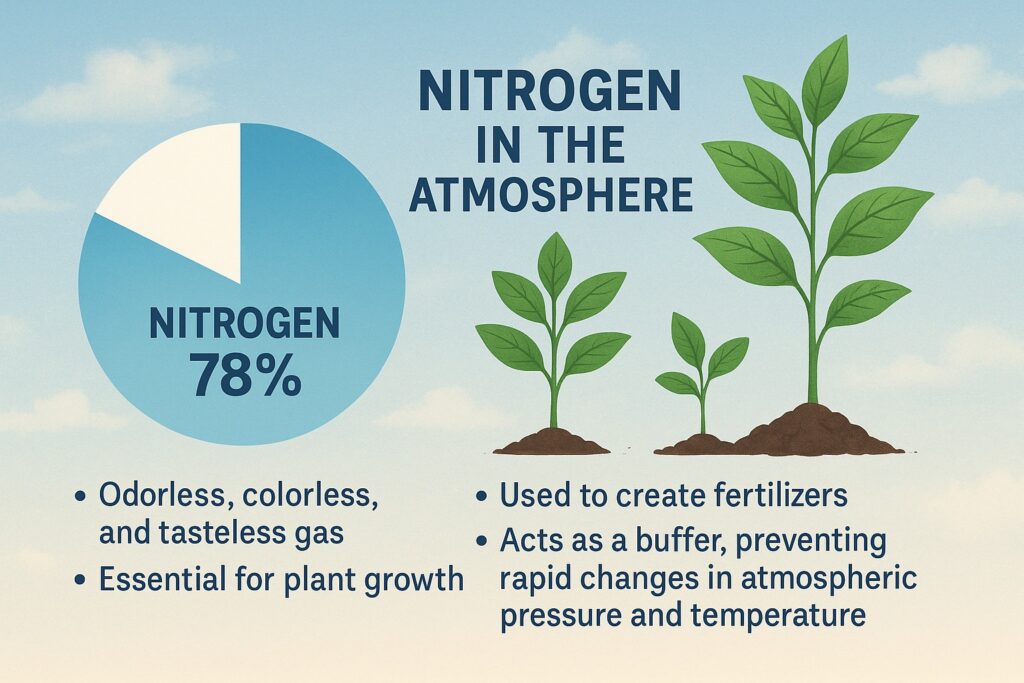The atmosphere is a vital component of the Earth’s ecosystem. It’s a layer of gases that surrounds the planet, providing essential conditions for life to exist. The atmosphere is made up of different gases that have unique properties, and their composition plays a crucial role in regulating the Earth’s climate and weather patterns. In this article, we will explore the composition of the atmosphere and its various gases.

Table of Contents
Composition of Atmosphere
The atmosphere is primarily made up of nitrogen, oxygen, and argon, with small traces of other gases. Nitrogen accounts for approximately 78% of the atmosphere, followed by oxygen at 21%, and argon at around 0.9%. The remaining 0.1% is composed of trace gases such as carbon dioxide, neon, helium, methane, and ozone.
The air around us is a mixture of many gases. Dry, clean air mostly contains:
- Nitrogen and oxygen, which make up 99% of the air.
- The remaining 1% includes gases like argon, carbon dioxide, hydrogen, helium, and ozone.
- It also has water vapor, dust, smoke, and salt particles.
The amount of these gases stays mostly the same up to 80 km above sea level, but other things like dust and smoke can change depending on where you are—like in cities versus villages.
Nitrogen
Nitrogen is the most abundant gas in the atmosphere, accounting for 78% of its composition. It’s an odorless, colorless, and tasteless gas that plays a vital role in many biological processes. Nitrogen is essential for plant growth and is also used to create fertilizers. In the atmosphere, nitrogen acts as a buffer to prevent rapid changes in atmospheric pressure and temperature.

Oxygen
Oxygen accounts for 21% of the atmosphere’s composition. It’s a colorless, odorless, and tasteless gas that is essential for the survival of most living organisms. Oxygen is used in cellular respiration, which is the process by which living organisms convert glucose into energy. Oxygen is also essential for the combustion of fuels, such as gasoline and natural gas.

Argon
Argon is the third most abundant gas in the atmosphere, accounting for approximately 0.9% of its composition. It’s an inert gas that does not react with other elements. Argon is often used in light bulbs and welding, as it can be used to create an inert atmosphere that prevents the oxidation of materials.
Trace Gases
Although trace gases make up a very small percentage of the atmosphere, they play a significant role in regulating the Earth’s climate and weather patterns. Carbon dioxide, for example, accounts for around 0.04% of the atmosphere’s composition, but it plays a crucial role in regulating the Earth’s temperature. Carbon dioxide is a greenhouse gas, which means that it traps heat from the sun and prevents it from escaping into space. This helps to keep the Earth’s temperature within a range that is suitable for life.

Another trace gas that is essential for life is ozone. Ozone is a molecule that is made up of three oxygen atoms, and it plays a crucial role in protecting the Earth from the harmful effects of ultraviolet radiation. Ozone is found in the Earth’s stratosphere, where it forms a protective layer that absorbs ultraviolet radiation from the sun.

Importance of Atmosphere
The atmosphere is the blanket of air that surrounds Earth. It stretches up to about 1,600 km above the ground, but most of the air (about 97%) is found within the first 30 km.
The atmosphere is made up of different gases that help life exist on Earth. It does several important jobs:
- It blocks harmful ultraviolet (UV) rays from the Sun.
- It keeps Earth’s temperature just right, not too hot and not too cold.
- It protects us from meteors—most of them burn up when they enter the atmosphere.
- It carries sound, so we can hear.
- It allows airplanes to fly.
- Carries sound so we can hear
In short: The atmosphere helps life survive by regulating temperature, protecting from UV rays and meteors, and carrying sound.
Composition of Atmosphere : Conclusion
The composition of the atmosphere is essential for regulating the Earth’s climate and weather patterns. Nitrogen, oxygen, and argon are the most abundant gases in the atmosphere, while trace gases such as carbon dioxide and ozone play a crucial role in regulating the Earth’s temperature and protecting it from harmful ultraviolet radiation. Understanding the composition of the atmosphere is essential for understanding the Earth’s ecosystem and the role that humans play in it.
Important Links